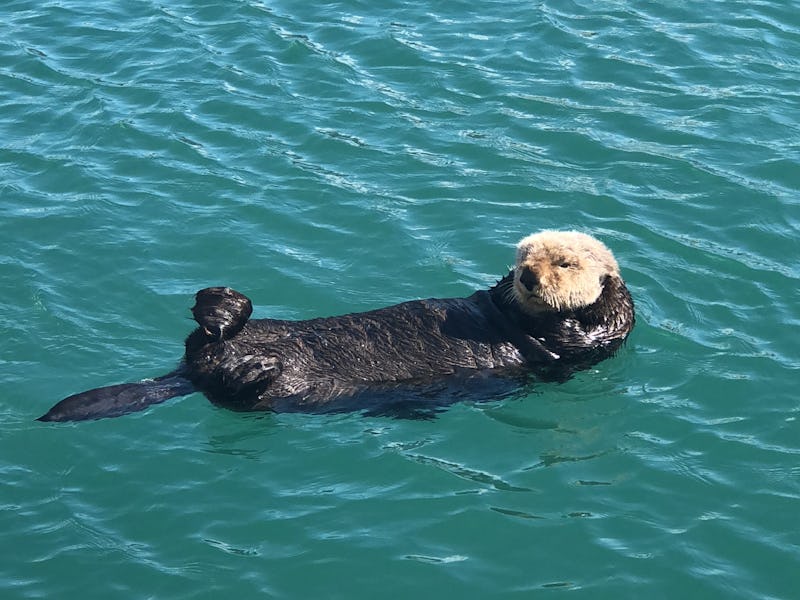A Creepy Disease in Outdoor Cats’ Poop Is Killing Sea Otters
They're not the first sea creatures to fall victim to house cats.

Even the most devoted cat lover must admit an uncomfortable truth about felines: They’re ecological hazards. Scientists blame cats for killing tens of billions of birds and small mammals each year, earning them the dubious honor of being one of the world’s top invasive species. Now, research in the journal Proceedings of the Royal Society B suggests that house cats are causing a different kind of problem, this time with some of the world’s cutest sea creatures.
In a paper published on Wednesday, researchers showed that multiple strains of the parasite Toxoplasma gondii, which is transmitted through cat poop, is killing southern sea otters (Enhydra lutris nereis) in California. Out of 116 freshly dead sea otter carcasses collected from California’s shores, T gondii was ruled a primary cause of death for 12 and a “contributing” cause of death for 21.
To conduct this study, California Department of Fish and Wildlife officials collected stranded otter carcasses, and researchers at the University of California, Davis, and the University of Nebraska School of Veterinary Medicine and Medical sciences performed detailed pathological exams on them.
The most likely explanation for the infections, they write, is that rainwater carried the oocysts — durable little biological capsules of immature T. gondii, ready to hatch and spring into action — from the land to the sea.
“Our data illustrate connections between T. gondii genotypes infecting terrestrial and marine hosts,” they write. Specifically, oocysts from several different strains of the parasite made their way from land to sea, where they became concentrated enough to infect a significant number of sea otters.
Sea otters are the most recent marine mammals to succumb to Toxoplasma gondii infections.
While the oocysts can be carried long distances in the ocean, coastal real estate development makes it especially easy for them to reach the sea. This happens not just as a result of more cats. The particular landscape of the human-built environment makes that likelihood even higher.
“Domestic cats also inhabit developed landscapes with impervious surfaces (e.g. concrete) that facilitate pathogen run-off and they have higher relative contributions to environmental oocyst load along many areas of the sea otter range,” they write. The simple solution to this would be to keep your cat indoors.
Unfortunately, this case isn’t the first time that cat poop has been linked to the deaths of marine mammals.
In November 2016, Inverse reported that endangered monk seals in Hawaii were falling victim to T. gondii infections.
Two years later, in July 2018, National Geographic reported that it was still happening.
A 2018 paper in the journal Diseases of Aquatic Organisms showed that 15 stranded beluga whales in Canada tested positive for T. gondii.
The parasite, which doesn’t kill cats, usually infects rats, mice, or birds — which are then eaten by cats. Then the cats poop out the oocysts, which disperse into the environment and infect rats or mice or birds, and the cycle continues.
But sometimes the oocysts find their way into other hosts, and the result, as in the case of these sea otters in California, is death either directly as a result of meningoencephalitis or indirectly in the form of decreased immunity to other infections.
As more marine mammals emerge as victims of T. gondii, the question remains the same: When will people stop letting their cats poop outside?
Abstract: Why some Toxoplasma gondii-infected southern sea otters (Enhydra lutris nereis) develop fatal toxoplasmosis while others have incidental or mild chronic infections has long puzzled the scientific community. We assessed robust datasets on T. gondii molecular characterization in relation to detailed necropsy and histopathology results to evaluate whether parasite genotype influences pathological outcomes in sea otters that stranded along the central California coast. Genotypes isolated from sea otters were also compared with T. gondii strains circulating in felids from nearby coastal regions to assess land-to-sea parasite transmission. The predominant T. gondii genotypes isolated from 135 necropsied sea otters were atypical Type X and Type X variants (79%), with the remainder (21%) belonging to Type II or Type II/X recombinants. All sea otters that died due to T. gondii as a primary cause of death were infected with Type X or X-variant T. gondii strains. The same atypical T. gondii strains were detected in sea otters with fatal toxoplasmosis and terrestrial felids from watersheds bordering the sea otter range. Our results confirm a land–sea connection for virulent T. gondii genotypes and highlight how faecal contamination can deliver lethal pathogens to coastal waters, leading to detrimental impacts on marine wildlife.